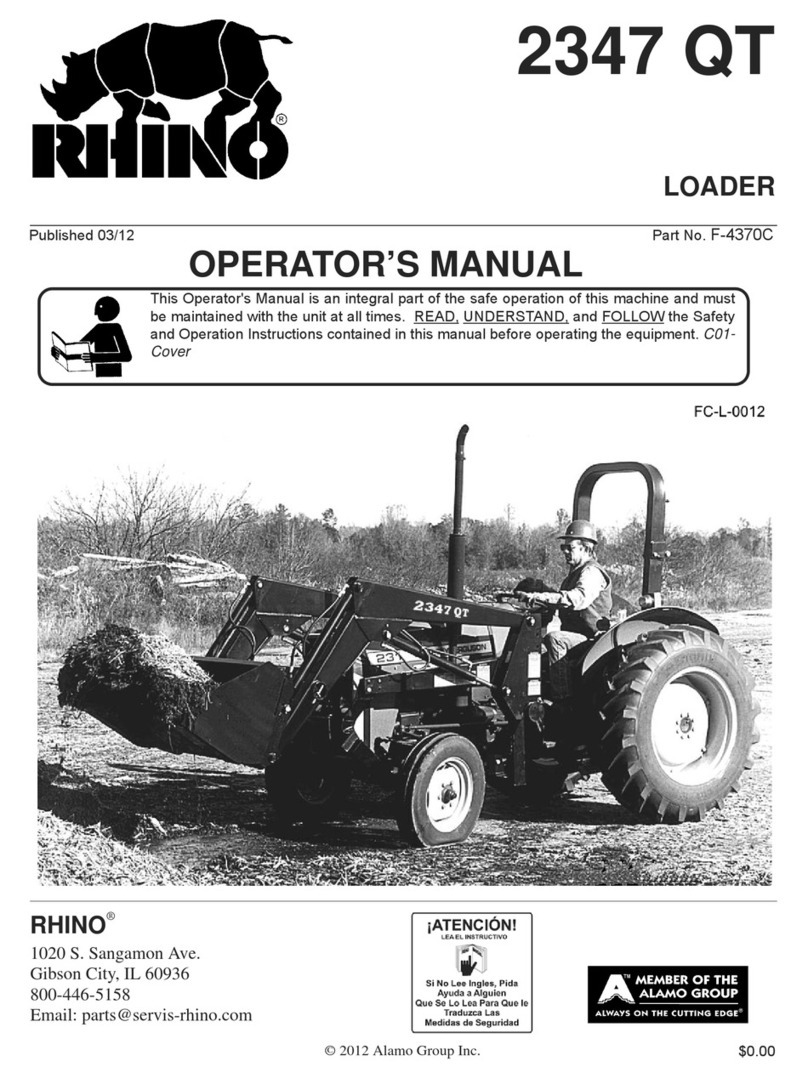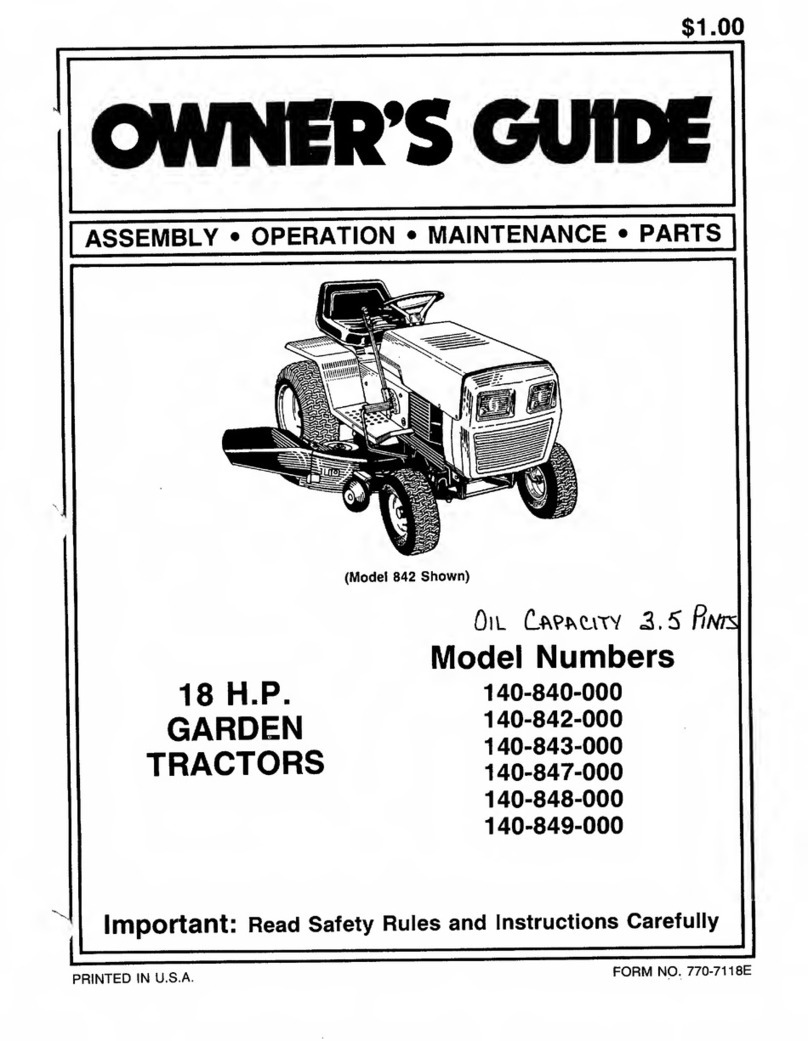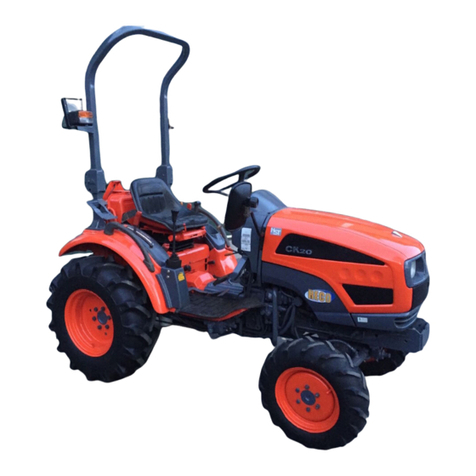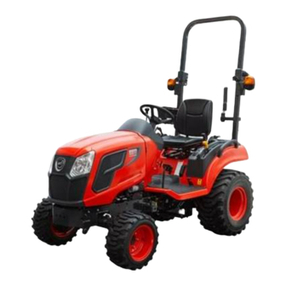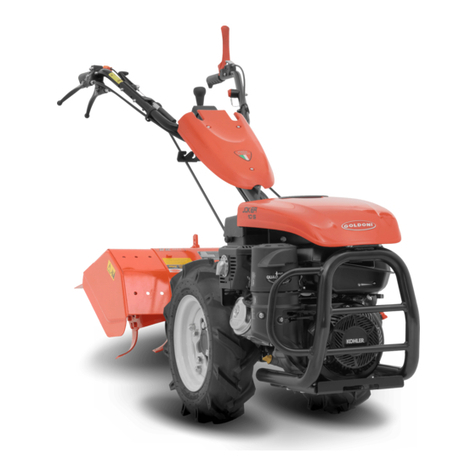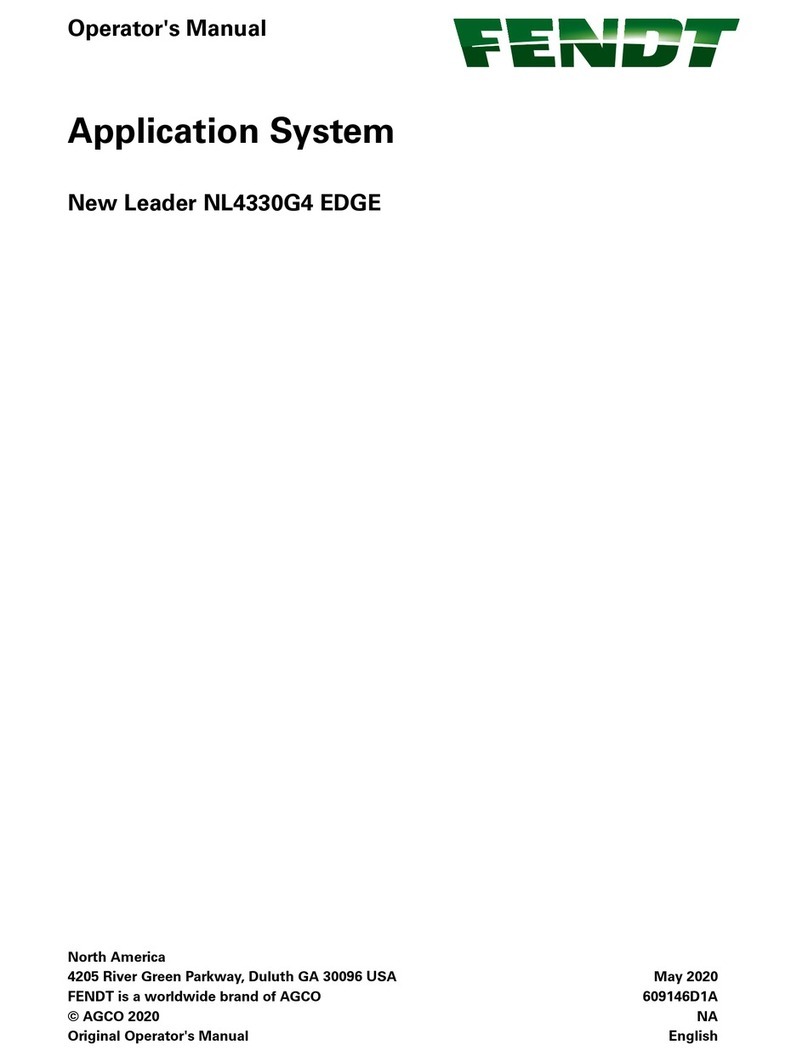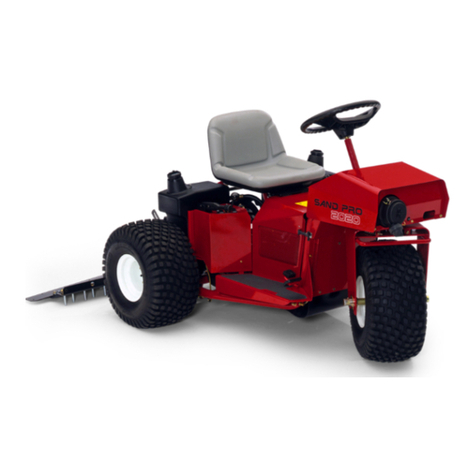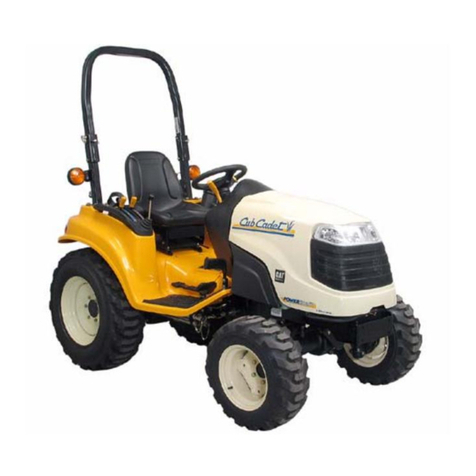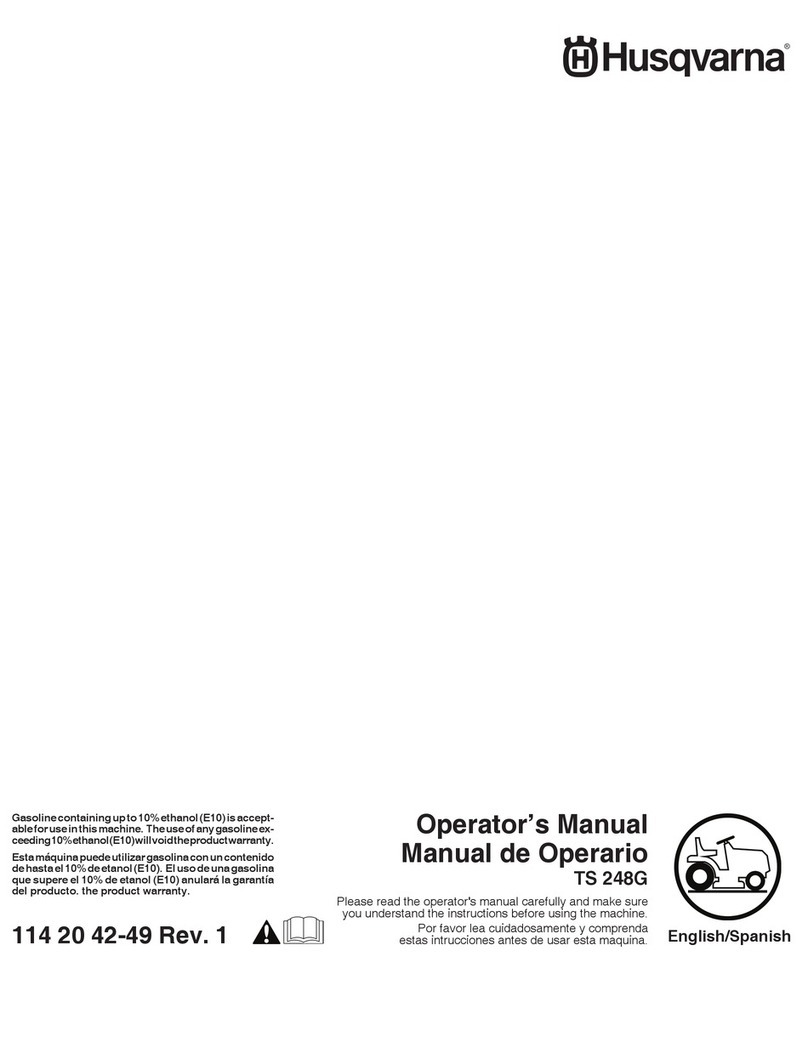Benassi BT 2001 R Manual

S.p.A.
OPERATING AND
MAINTENANCE MANUAL
For
BT 2001 R
Tractor Series
10/07/01

S.p.A. BT 2001 R
2
IMPORTANT: Please read carefully this manual before operating the
tractor; it will allow you to obtain the best performances from your
machine. Failure to comply with these instructions could lead to personal
injury, or damage to the tractor.
INTRODUCTION
ØThank you for purchasing our product. You are a valued customer.
ØIn this manual you will find the information needed to operate and maintain your tractor.
ØThe better you know your machine the safer you will be when operating it: therefore we advise you to read carefully
and understand this manual "OPERATING AND MAINTENANCE" before starting work.
ØYou will find important warning notices on the use of the machine, information about maintenance and care, safety
rules and operating advice that will help you maintain your machine’s value over time.
ØThe BENASSI Company reserve the right to modify mechanical parts, finish and accessories, future technical
progress. Data concerning measurements, weighs and performances are to be considered with tolerance referring to
the DIN norm.
ØFigures, descriptions and technical data are not binding.
TECHNICAL ASSISTANCE AND WARRANTY
ØThe BENASSI Company offers technical assistance to customers through its distribution network, in order to
resolve problems concerning operation and maintenance. The machines are guaranteed for 12 months (one year) from
time of delivery. Warranty covers faulty material. The special document (warranty data) is joint to the machine.
ØGrease and consumable materials are always charged to the purchaser.
ØWith reference to the warranty of the engine, the engine manufacture is responsible.
ØWarranty does not cover the electrical system, lights, battery, tyres, gaskets, clutch plates, and consumable
materials that wear out due to use.
LABOUR AND TRANSPORT COSTS ARE ALWAYS CHARGED TO THE PURCHASER.
AFTER SALE SERVICE
When ordering spare parts, please state precisely:
•registration number
•code number of the spare part ordered
•quantity required
If any information is unclear, please contact the dealer where the machine was purchased.
Use genuine BENASSI products, spare parts and accessories. Any kind of modification or application not
genuine will relieve BENASSI of any responsibility.
The BENASSI Company declines all responsibility in cases of application to its machines of accessories
produced by other manufacturers, without authorisation.
Warranty terminated
•If the identification number on the machine have
been changed
•If the tractor has had an accident
•If the delivery certificate has not been filled in
correctly or if it has not been sent back to the
manufacturer
•If modifications are made without the authorisation
of the manufacturer
Any claim against supply or mistakes must be put forward within 8 days from the delivery date. In case of
controversy, the competent court is the court of Bologna.

S.p.A. BT 2001 R
3
CONTENTS:
1. Safety rules and limits on use
2. Instructions on tractor operation
3. Instructions on transporting and towing
4. Use of tools
5. Technical data and characteristics
6. General dimensions and weight
7. Identification of the machine
8. Identification of safety decals
9. Identification of Dashboard controls
10. Identification of main parts and controls
11. Operating controls
12. Operating the tractor
13. Starting the engine
14. Stopping the engine
15. Setting the machine in motion
16. Stopping the machine
17. Differential Lock
18. Operating PTO shaft
19. Use of the electric lift
20. Use of the 3 point-linkage
21. Operating on the road
22. Use of towing brackets
23. Use of ballast
24. Track adjustment
25. Periodical maintenance
26. Water ballasting
27. Adjustments
28. Electrical system
29. Maintenance
30. Tractor Storage
1) SAFETY RULES AND LIMITS ON USE
CAUTION !
This symbol indicates that failure to comply with these rules may lead to personal injury.
Further danger sign plates are placed on dangerous parts of the machine.
GENRAL INFORMATION
ENGINE AND MACHINE MANUALS
Read carefully both MANUALS before starting, using,
servicing or fuelling the tractor.
TRAINING
The operator must be fully trained on the controls
before using the machine.
PLATES
Read all the plates located on the tractor and respect
the rules reported on these plates before, starting,
operating, fuelling or servicing the machine. Replace any
damaged plates.
PRUDENCE
Prudence is necessary. It’s the best rule to avoid
accidents.
HEALTH
Do not operate the tractor if you are physically unfit.
SUITABLE CLOTHES
Do not wear lose fitting clothes, that may be caught on
moving parts of the machine. During maintenance
operations and fitting of tools to the tractor, always
wear sturdy gloves.
Never work in bare feet or sandals. Wear sturdy shoes
and long trousers.
ENGINE R.P.M.
Do not adjust the calibration of the engine covener.
Excessive speed of the engine increases the risk of
accident.
NOISE
In order to reduce the effects of noise, you should,
-Not run the engine at peak r. p. m.
-Use ear protections.
FIRST AID
You are advised to keep a first aid kit with the tractor.
SAFETY DEVICES
Electric Tool lift
When driving on the road, the three-point linkage must
be kept completely raised.
Do not use the machine if safety devices are not
working correctly.
Do not tamper with any safety device.

S.p.A. BT 2001 R
4
STARTING THE ENGINE
Read the operating and maintenance manual before
starting the engine
Before starting the engine, make sure that the hand
brake is engaged, the clutch lever is down and the
control levers are disengaged.
Do not start the engine (by means of the key) if you are
not seated at the driver’s seat.
Do not leave the engine running in an enclosed space, as
exhaust gases are toxic.
2) INSTRUCTIONS ON TRACTOR OPERATION
Do not operate the tractor near other people, especially
children, or animals.
The operator is responsible for injury or
damage caused to people or property.
Do not transport passengers on the wheel
arches or on other parts of the tractor. Danger
of being dragged or crushed by the moving parts of the
machine.
Never leave the tractor unattended with the engine
running, especially near dry shrubs or other
inflammables.
Familiarise yourself with the controls and learn to use
the machine correctly. Learn to switch off the engine
quickly.
Do not allow children or strangers to operate the
tractor. In order to avoid the risk of burns, keep a
safe distance from the engine and exhaust.
Do not get on or get off the tractor while it’s
moving.
If the tractor is drawing powered implements and the
PTO shaft is under stress, do not turn suddenly to avoid
the risk of damage to the universal joint.
Use the tractor only in condition of clear visibility.
Work in condition of safety and stability, especially when
you are working on a slope.
When you are on a slope, do not work transversally.
Pay special attention when changing direction.
Do not work on slopes greater than 15°.
Do not use the machine if the protections or safety
devices are faulty or if they have been removed.
Keep hands and feet clear of tools fitted to the machine.
Do not lift or transport the machine with the engine
running.
When driving the tractor down a slope, use a forward
gear; do not disengage the clutch.
Tractor speed must be, relative to the ground condition,
When working on uneven ground, operate the tractor
carefully to assure the stability of the machine.
When you are driving on the road, observe the rules of
the road.

S.p.A. BT 2001 R
5
3) INSTRUCTION ON TRANSPORTING AND DRAWING
The tractor is not permitted to tow any object with a weight exceeding the legal limit, on the
road.
Do not use the three-point linkage to tow.
4) USE OF TOOLS
Keep hands and feet clear of implements fitted to the PTO shaft: danger of being dragged or crushed by moving parts.
Keep hands and feet clear of the implement lifter, and do not stand near to it, because of the danger of being crushed.
When connecting implements to the tractor, make sure nobody is between the two.
Do not use the PTO shaft if children or animals are near the tractor.
The manufacturer decline all responsibility for damages caused by improper operating of the safety devices.
5) TECHNICAL DATA AND CHARACTERISTICS
Engine
ØDiesel
ØTYPE: RUGGERINI MD151
ØNumber cylinders: 2
ØSwept volume (cm³ ) 654
ØPower: 12 kW (16,3 HP) (DIN 70020)
ØR. p. m. max. : 3600 giri/1'
ØCooling plant: air-cooling
ØInjection system: direct
ØOil bath Air filter
ØFuel: Diesel
ØEngine oil: AGIP SUPER DIESEL MULTIGRADE 15W/40
Clutch:
ØDry Single-plate with pedal control
Starting:
ØElectric with 12 volt battery.
Traction:
ØTwo driving wheels with differential lock.
TRANSMISSION:
ØOil bath gears with 3 forward speeds and 2 speeds in
reverse. Quick action forward/reversal lever.
ØDifferential lock.
SPEED TABLE
SPEED KM/H with wheels
6.5/80.15 KM/H with wheels
6.00.16
I forward 2,15 2,32
II forward 4,31 4,65
III forward 15,6 16,8
I reverse 2,68 2,89
II reverse 5,35 5,77
PTO SHAFT
Independent of 1 speed gear (600 r.p.m. with motor at
3600 r.p.m.) with section ASAE 1-3/8"
FRONT AXLE:
Floating and extendable to 3 positions.
ELECTRIC LIFT
Electric type with 3 point-linkage CAT 1
Capacity: 2550 N (260Kg)
Jack: model LA10 (see joint paper with technical data)
STEERING-GEAR
Mechanical type: endless screw and toothed helical section
BRAKES
Mechanical drum brakes. Independent and park.
STANDARD TYRES
TRACTOR 6.5/80.15 Back
DIRECTIONAL 4.00.8 Front
Tyre type Pressure
4.00.8 2PR 2,6 bar
6.5/80.15 4PR 1,8 bar
4.00.10 2PR 2,6 bar
6.00.16 4PR 1,8 bar
OPTIONAL TYRES
TRACTOR 6.00.16 Back
DIRECTIONAL 4.00.10 Front
DIMENSIONS variable track.
External width 740-820-940 mm.
Wheelbase: 1120 mm.
IMPLEMENTS
Topper, plough, rotovator, flail, shredder, rotating scythe,
snow blower, finishing mower:
Can be fitted to the rear three-point linkage
Certain implements may be fitted to the front of the
tractor.
Towing bracket
Front (for moving on the road)
Back (for towing on the road)
Mod. GTF 30-10
Approval act: CE -97-099
Rear-view mirror (driving on the road)
With Engine at 3600 r. p. m.

S.p.A. BT 2001 R
6
BODYWORK
Hinged bonnet, fixed arches for back wheels, adjustable
seat with suspension.
ELECTRICAL SYSTEM
The circuits used in the system, to power the electric horn
and rotating light are fed by fuses type-tested for moving
on the road.
FUEL
Tank capacity 6 litres
Gearbox OIL ROTRA MP SAE 80W90: 12 litres.
Oil Capacity of the engine (MD151): 1,8. Litres.
6) GENERAL DIMENSIONS AND WEIGHT
The machine’s overall dimensions are listed in Fig. 1
Total weight with standard wheels: 410 Kg.
Total weight with optional wheels: 430 Kg.
Fig. 1
Total without back ballast
Back tyres 6.00-16 Tractor
Front tyres 4.00-10 Dir.
Total without front ballast
Back tyres 6.5/80-15 Tractor
Front tyres 4.00-8 Dir.
7) IDENTIFICATION OF THE MACHINE
The machine is identified by the V.I.N. code; this is stamped on the clutch bellhousing. The registration number of the
engine is stamped on the engine plate.
Identifying data is on the manufacturer’s plate fixed on the chassis (see fig.2)
V.I.N. code
Code composition:
ZA9 6800000 0G78070
Sequence of Figures: from 0 to 9

S.p.A. BT 2001 R
7
Left side
8) IDENTIFICATION OF SAFETY DECALS
IMPORTANT: To prevent accidents all decals fitted to the machine must be clearly visible.
If decals become damaged replace them at once.
SAFETY PLATES
Absorption
coefficient
plate
Manufacturer
plate
Identifying number
engine plate

S.p.A. BT 2001 R
8
DIRECTION PLATES
1 3 MAX 4
2
MIN
2a) 3a) 5)
6) 7)
1) DECAL: RIGHT FOOT POSITION WHEN NOT USING THE CLUTCH PEDAL
2) and 2a) DECAL: FOR CLUTCH “ENGAGEMENT-DISENGAGEMENT”
3) and 3a) DECAL: FOR ACCELERATOR “MIN -MAX”
4) DECAL: FOR GEARS
5) DECAL: FOR PTO SHAFT ENGAGEMENT-DISENGAGEMENT
6) DECAL: FOR 3 POINT-LINKAGE LIFTER, PLACED ON THE RIGHT WING
7) DECAL: FOR ABSORPTION COEFFICIENT, PLACED ON THE CHASSIS, NEAR TO THE MANUFACTURER PLATE.

S.p.A. BT 2001 R
9
9) IDENTIFICATION OF DASHBOARD CONTROLS
Fig. 3
1) Ignition Key.
2) Hazard indicator switch.
3) Main beam warning light (blue)
4) Dipped beam warning light(green)
5) Directional indicator, plus hazard warning light (green)
6) Fuel indicator (orange) lights up when 1 litre of fuel
remains in the tank.
7) Engine oil pressure light (red).
8) Ignition light (red)
9) Rev counter. Measures the engine shaft and the rear
PTO shaft revolutions.
10) Hour counter. Measures effective time of engine
operation.
11) Indicator stem, incorporating light switches and horn
button.
Position ΟΟ Lights off
Position side lights, number-plate light on
Pos. Main beam on.
By pushing button (11) at the end of the
indicator stem the electric horn is operated.
12) Optional

S.p.A. BT 2001 R
10
10) IDENDIFICATION OF THE MAIN PARTS AND CONTROLS
Fig. 4
Fig. 5

S.p.A. BT 2001 R
11
Fig. 6
DESCRIPTION OF PARTS IN FIG. 4
1) WHEEL ARCH
2) DIFFERENTIAL LOCK
3) LEFT BRAKE PEDAL
4) RIGHT BRAKE PEDAL
5) BRAKE PEDAL LOCKING LEVER
6) ADJUSTABLE FRONT AXLE
7) FRONT BUMPER
8) LIGHTS
9) BONNET
10) ACCELERATOR LEVER
11) BONNET LIFTING POINT
12) DASHBOARD
13) SEAT ADJUSTMENT LEVER
14) SEAT
15) BACK LIGHTS
DESCRIPTION OF PARTS IN FIG. 5
1) CLUTCH PEDAL
2) FOOTREST PLATFORM
3) BACK WHEEL –TYPE TRACTOR
4) REAR PTO SHAFT
5) REAR TOWING BRACKET
6) THREE-POINT LINKAGE
7) ELECTRIC LIFT
8) NUMBER-PLATE LIGHT
9) REAR REFLECTORS
10) FUSE BOX
11) STEERING-WHEEL
12) REAR-VIEW MIRROR
13) SILENCER
14) ENGINE
15) DIRECTIONAL FRONT WHEEL
DESCRIPTION OF PARTS IN FIG. 6
1) CONTROL BUTTON FOR REAR THREE POINT
LINKAGE LIFTER. FRONT LIFTER AND
ELECTROMAGNETIC CLUTCH (OPTIONAL)
2) FORWARD AND REVERCE DIRECTION LEVER
3) GEAR INDICATING PLATE
4) OIL LEVEL CAP. CHANGE AND VENT-HOLE
5) PARKING BRAKE LEVER
6) PTO SHAFT ENGAGEMENT-DISENGAGEMENT
LEVER
7) GEAR LEVER

S.p.A. BT 2001 R
12
11) OPERATING CONTROLS
Steering-wheel
See figure 5, point 11. Operates the rack steering gear to
turn the front wheels.
Accelerator lever
See figure 4, point10
While moving, you can increase the speed, by pulling the lever
back. By pushing the lever forward you will reduce the speed.
Brake pedals
See figure 4, points 3 and 4. By pressing the pedals, the
brakes on both the back wheels are applied:
Pedals can also be used separately in order to facilitate
narrow steering operations. While moving on the road, pedals
must be connected, by means of the special connecting plate
(fig.4, point 5).
Clutch pedal
See figure 5, point 1
-Press the pedal to disengage the clutch.
-Release the pedal to engage the clutch.
N O T E
The clutch pedal unit is provided with a safety switch that
does not allow the tractor to start if the pedal is not
completely pressed.
FORWARD/REVERCE LEVER
See figure 6, point 2
-When the lever is in the forward position, the tractor
moves forward.
-When the lever is in the rear position, the tractor moves
in reverse
Attention:
The selection of forward or reverse gear must be engaged by
operating the clutch.
Gear control lever
See figure 6, point 7
-By means of the gear lever you can select 3 forward
speeds (with 2 intermediate neutral position)
-when the gear lever is in the reverse position
-You can select 2 speeds in reverse gear (position 1 and 2)
with one intermediate neutral position,
PARKING BRAKE.
See figure 6, point 5. Pull up the lever to operate the brake;
in this position the red stoplights eliminate. See figure 4 point
15.
Press button at the end of lever and lower to release the
brake.
Rear-differential locking/unlocking pedal.
See figure 4, point 2. The differential locking device is used
when ground conditions are critical and the machine has to
work with the strongest traction. For example, on slope or
when the wheels are slipping.
By pressing the pedal you can lock the differential, which is
automatically unlocked when you release the pedal.
ATTENTION
Before locking the differential you have to slow the tractor
speed.
Control lever of rear PTO shaft
See figure 6, point 6.
Engagement / disengagement of the rear PTO shaft Fig.5
Point 4. Press the clutch pedal, keeping the engine running.
-Lever in the left position: PTO disengaged
-Lever in the right position: PTO engaged
Rotation speed: 600 r.p.m. With motor at 3600 r.p.m.
Switch for the back lifter.
See figure 6, Point 1. Press the switch to lower or raise the
three-point linkage Fig.5 Ref. 6. By means of the electric lift
switch Fig.5 Reference 7.
Two others switches are on the wing in order to control
accessories.
12) USE OF THE TRACTOR
ATTENTION
Before operating the tractor, read the chapter 1 “SAFETY
RULES” of this manual.
SEAT ADJUSTEMENT
Longitudinal adjustment
You can move the seat backwards or forward by pulling the
lever (see figure 4 and 5 point 13); when the right position is
found, release the lever to lock the seat. (Max. movement 60
mm.). For other seat adjustments: see figure 5'.
RUNNING IN
During the first 50 hours of use (running in period), it’s
better to avoid using the machine in particularly hard ground.
Keep the engine power below 70% of the maximum potential
power. When the running in period is finished, these
operations are to be done:
Engine: follow the instructions in the use and maintenance
manual.
ØGear box: check the oil level, as instructed in the charter
“Maintenance”.
ØMechanical parts: check that all nuts and bolts are tight.
Tyres: check the tyre pressure (see the table in the charter
“Technical data and characteristics”.)

S.p.A. BT 2001 R
13
Fig. 5'
13) STARTING THE MOTOR
For information concerning the engine, read the
Use and Maintenance Manual.
Check before starting the engine:
ØCheck the fuel level; use the recommended fuel.
See Technical data and characteristics
ØCheck the oil level in the engine.
Starting
Sit correctly on the driver’s seat. Make sure that the park
brake is on. Fig.6 Réf.5. Make sure that the gear change
lever (fig.6 Ref. 7) and forward/reverse lever (Fig.6
Ref.2) are in neutral position. Press the clutch pedal (Fig.5
Ref.1) to close the starting switch, and turn the key as
follows: O= No circuit connected.
I= Switching on tools and indicators (working
position).
II= Starting the engine.
When engine starts: release the key; the key automatically
returns to the working position I.
ATTENTION
The clutch pedal is fitted with a safety switch which
prevents the engine from starting if the pedal is not
completely pressed.
Check the indicators and the control tools.
Before starting, when the key is in the I position, check
that the indicators Ref.7 and Ref.8 (fig. 3) light.
If an indicator doesn’t light, probably a bulb has burnt out.
Before using the tractor, change the faulty bulb.
With the engine running, and before starting to use the
tractor, check that all the indicator lights on the
dashboard are off.
ATTENTION
If the oil pressure indicator doesn’t go out, this could be
caused by a problem in the electric system or by the
failure in checking as indicated in the chapter “Checking
before Starting”.
If the ignition light doesn’t go out, this could be due to an
insufficient supply from the alternator.
Eliminate every problem, before going on.
Make sure that all control levers are engaged. Release the
clutch pedal gradually. (Fig.5 Ref. 1).
At the end of the work, check the hours counter and the
fuel level. (Ref.10 and Ref.6 Fig.3). Warm up the engine.
ADVICE
If the engine doesn’t start, return the key to position 0,
wait a moment and try again.
14) STOPPING THE ENGINE
Disengage both gear control levers.
Engage park brake lever Fig.6 Ref.5
Lower engine r.p.m.
Turn key from position I to position 0. Ref.1 Fig.3
Suspension
adjustment for
driver’s seat
weight (from 50
Kg. to 130 Kg.)
Control for the
longitudinal seat
adjustment.
(movement of 60
mm.)

S.p.A. BT 2001 R
14
15) SETTING THE MACHINE IN MOTION
Before moving forward, check the efficiency of
the brakes.
ØPull the accelerator lever (Ref.10 Fig.4) to it’s
intermediate position. Disengage the clutch by de-
pressing the foot pedal, with the engine running.
(Fig.5 Ref.1) (Ref.10 Fig.4)
ØEngage the forward/reverse lever Ref.2 Fig.6. Lever
forward: the tractor moves forward.
Backward the tractor moves in reverse.
Attention: Intermediate position neutral
ØSelect the gear by means of the change gear lever
Ref.7 Fig.6. Select the gear by referring to the
plate Ref.3 Fig.6
POSITION:
1) 1st forward speed or 1st speed in reverse.
2) 2nd forward speed or 2nd speed in reverse.
3) 3rd forward speed only.
Disengage the park brake, by releasing the lever Fig.6
Ref.5
ØRelease the clutch pedal gradually (Fig.5 Ref.1)
ØAccelerate by means of the lever Ref.10 Fig.4.
ATTENTION: when you pull up the control lever of the
reverse gear Ref. 2 Fig.6, the change lever (Ref.7 Fig.6)
is automatically disengaged if this is in 3rd position.
USE OF THE CLUTCH PEDAL
Operate the clutch pedal in these circumstances only:
Øto start the engine
Øto operate the forward/reverse lever and the
gear lever
Øto engage or disengage the PTO shaft
ØTo operate the engine start safety device.
ADVICE
When moving do not keep your foot on the clutch pedal.
A prolonged clutch disengagement deteriorates the
thrust bearing.
16) STOPPING THE MACHINE
STOPPING THE MACHINE
Return the accelerator to the idle speed position (Ref.10 Fig.4)
Press the clutch pedal (Ref.1 FIG.5) and the brake pedal. (Ref.3 or Ref.5 Fig.4)
Engage the park brake (Ref.5 Fig.6).
Return the gear change lever (Ref.7 Fig.6) and the forward/reversing lever (Ref.2 Fig.6) to
the neutral position.
Stop the engine, by turning the key (ref.1 fig.3) to the 0 position
17) DIFFERENTIAL LOCK
The tractor is fitted with a mechanical locking device on
the differential, in the rear axle. This will allow you to
obtain the best performances from the machine.
Press the pedal Ref.2 Fig.4 to lock the differential.
The differential is unlocked when the pedal is up.
Lock the differential only in exceptional circumstances:
when one wheel is slipping.
Use the differential lock when ploughing, for better
traction on the rear wheels.
Use the differential lock only at lower speeds.
Reduce r.p.m. of the engine before locking the
differential. Do not lock the differential while turning.
If the differential doesn’t unlock, reduce the r.p.m. of
the engine, stop the machine and unlock the differential
by operating on the steering-gear or/and the clutch.
18) OPERATING PTO SHAFT
The tractor is fitted with a single rear PTO (Ref.1 Fig.7)
with profile ASAE 1-3/8” with clockwise rotation when
the lever 2 Fig. 6 is forward, and anticlockwise rotation
when the lever 2 is in the reverce position. In order to
engage the PTO; disengage the clutch by pressing the
foot pedal Ref.1 Fig.5.
Engage the PTO by means of the lever Ref.6 Fig.6.
Engage the clutch by releasing the pedal Ref.1 Fig.5
The revulsion of the PTO is not coverened by the gear
position.
Fig. 7

S.p.A. BT 2001 R
15
ADVICE
Do not connect tools or operate machines that need a
greater power than that available. If you have doubts
about the available power, call the Technical Assistance
Service.
To stop the PTO shaft, press the clutch pedal and pull
the lever (Ref.6 Fig.6) completely to the left
(disengagement position).
Fitting the PTO shaft
To fit the PTO shaft follow the instructions below:
A. Remove the protection from the end of the PTO
(Ref.2 fig.7), by unscrewing side screws (Ref.3 fig.4)
B. Fit the shaft to the PTO. Make sure that the shaft
is properly fitted to the tractor, as stated in the
instruction notes, which are provided with the shaft.
In order to insert the shaft on the spline, you have
to press the locking pin fully, which then allows the
shaft to be coupled to the tractor PTO.
C. Put the protection back over the PTO, by screwing
the fixing screws.
D. Connect the safety chains to the tractor and to the
implement.
The transmission shaft, used to transmit power
from the tractor to the operating machine, must not be
used without safety guards or with faulty guards.
WHILE WORKING, THE COVER OVER THE PTO
SHAFT MUST ALWAYS CONNECTED.
19) USE OF ELECTRIC LIFT
The tractor is equipped with a rear-electric lift connected to the three-point linkage.
The lift has a control switch Fig.6 Ref.1. press the switch Ref.1 Fig.9 to raise or lower the arms Ref.2 Fig.9.
-Press the switch (Ref.1 Fig.6) on its upper part to lift arms.
-Press the switch (Ref.1 Fig.6) on its lower part to lower arms.
-When you are not pressing the switch, the electric device is off but arms can be in their lifted position (BENASSI
PATENT) 20) USE OF THE THREE POINT LINKAGE
The tractor is equipped with a three-point linkage (see
figure 9). The linkage is connected to the arms of the
electric lift described in the paragraph above. It allows
you to connect various implements to the machine.
It is made up of the following parts:
-To lower arms Ref.4 and a top link Ref. 3 Fig.9,
hinged on the body of the tractor.
-An adjustable vertical connecting rod Ref.5 Fig.9
and a fixed connecting-rod Ref.6 Fig.9, which
connect the lower arms Ref.4 Fig.9 to the arms of
the lift Ref.2 Fig.9.
By adjusting the three Points Ref.3 Fig.9 and the
adjustable vertical connecting-rod Ref.5 Fig.9, it is
possible to fit the three-points linkage to any kind of
implement.
-Two chains Ref.6 fig.9 are connected to the lower
arms Ref.4 Fig.9. They allow adjustment of the two
arms by means of the rings of the chain.
-After coupling the implement, it is necessary to
make the right adjustments in order that the
implement dose not lift excessively when the lift is
in the upper position, and that the tool dose not
touch the ground when it is in the lower position.
MAXIMUM WEIGHT ON THE LIFTING ARMS: KG.260
Fig. 9
CAUTION
If you are not using any implement, the lower arms Ref.4
Fig.9 are to be adjusted by means of the chains in the
last ring, in order to avoid transverse stress on the joint,
in particular while moving on the road.
Adjust the lower arms so that the chain tightens, by
keeping the arms in the narrowest position, to eliminate
any oscillation.
Furthermore, you must disconnect the top link Ref.3
Fig.9, by unhooking the pin Ref.7 Fig.9 and pulling out the
fixing pivot. In this way any vibration will be avoided.
ATTENTION
Concerning the connection and use of accessories (e.g.
milling-cutter group, plough), follow the instructions in
the manual that accompanies the accessory.

S.p.A. BT 2001 R
16
.21) MOVING ON THE ROAD
The tractor conforms to EC regulations, it can move on
the road, if the following conditions are respected:
ØThe tractor must be registered and insured. It must
be equipped with a plate, which has to be fitted
correctly.
ØIt must be equipped with a working light system.
ØThe brake system must be efficient.
ØThe driver must have a valid driving licence.
ØThe rear-lift must be in its highest position and the
arms locked (ref.4 fig.9), if no implement is fitted, as
it is indicated in the paragraph “Use of the three point
linkage”. Always remove the top link (ref.3 fig.9) if it is
not connected with any implement.
ØMoving on the road with implements fitted to the
tractor is allowed, if the instructions stated above are
respected and only within the limits stated in the
highway regulations. The lights must be visible and the
flashing amber light must be working during the day.
ØIn order to move the tractor on the road, start the
machine and select the transmission gear as indicated
in the paragraph “STARTING THE MOTOR”.
22) USE OF TOWING BRACKETS
The tractor can be fitted with a front towing bracket
and two types of rear towing brackets.
Front towing bracket fig.10 ref.1 is to be used for towing
the tractor in an emergency, and it is obligatory when
the tractor is travelling on the road. Rear towing bracket
is the standard one (fig.11 ref.1) for towing agricultural
accessories.
A CE certified rear-towing bracket is also available. See
fig.9 ref.8
This bracket can be used for towing on the road and can
be connected to a single-axle trailer. This trailer must
be certified and its characteristics have to conform to
those stated on the tractor’s plate (see point 7).
Fit the towing bracket correctly. Fit the hand brake.
Connect the trailer’s electric system with the power
point (ref.1, fig.12), on the back of the tractor.
ATTENTION
When you are towing a trailer on a slope greater than
10%, you must use a front-ballast of 60 KG.
Fig.10 Fig.11

S.p.A. BT 2001 R
17
Fig.12 Fig.13
23) USE OF BALLASTS
The use of ballast is necessary when the wheels slip due to insufficient adhesion to the ground.
In this case, it is necessary to apply the metal modular weights Fig.13 Ref.1, which can be attached to the front bumper.
Use the appropriate threaded rods and nuts to fix the ballast. The rod Ref.2 Fig.13 is used to fix the ballast to the
bumper while the rod Ref.3 Fig.13 is used to hold the ballast together.
Total Weight of Front Ballast: 60 kg.
When towing, front ballast of 60 kg max. is permitted.
24) TRACK ADJUSTMENT
The rear tyre rims fitted to the tractor can be adjusted in order to adjust the track of the tractor to different work
conditions.
Track adjustment is by re-positioning the rims to the relative plates on the hubs.
FRONT. Measurement in mm.
L2 TYRES C2 M2 C2 M2 C2 M2 C2 M2
ON
ADJUSTABLE
AXLE
1ST
POSITION
2ND
POSITION 3RD
POSITION 4TH
POSITION
100 4.00.8610 710 670 770 730 830 790 890
100 4.00.10 610 710 670 770 730 830 790 990
REAR. Measures in mm.
L1 TYRES C1 M1 C1 M
1C1 M1
WITH
ADJUSTABLE
PLATE
1ST POSITION 2ND POSITION 3RD POSITION
165 6.5/80.15 585 750 645 810 775 940
170 6.00.16 590 760 650 820 780 950

S.p.A. BT 2001 R
18
FRONT AXLE ADJUSTMENT
Track adjustment on the front axle allows 4 different widths, as shown in the preceding tables. To adjust the track,
loosen and remove the nuts and bolts (2 on the left, Ref.1 fig.14 and 2 on the right, Ref.1 fig.15) adjust the axle. Replace
the bolts in the appropriate position. Refit the nuts. Finally, adjust the steering connecting-rod ref.2 fig.14.
Fig.14 Fig.15
ADJUSTING RIMS OF REAR-WHEELS
Ref.1 Fig.16 and Ref.2 Fig.16, show the adjustment points for the rear
axle. Three widths are available; the measurements are indicated in
the table above.
Fig.16
25) MAINTENANCE
PERIODICAL MAINTENANCE
Use only original spare parts, to ensure maximum
efficiency of the machine.
ATTENTION
Before starting maintenance operations, read the
instructions in the paragraph "SAFETY NOTES".
ADIVICE
ØOil level checks are to be made with the machine in a
level position and with the engine stopped for at least
10 minutes.
ØChange the oil while still warm; in order to facilitate
emptying.
ATTENTION
Oil change operations must be done in conformity with
pollution regulations.
The table below shows the maintenance and lubricating
operations that are to be done periodically.
NOTE
The working hours of the machine are measured by the meter fitted to the dashboard of the tractor (ref.10 fig.3). The
following paragraphs describe maintenance operations in detail.

S.p.A. BT 2001 R
19
PERIOD PART OPERATION
During first 50 hours (running in) •Diesel Engine
•Wheels •Check the oil level
•Check that wheel nuts are tight
After first 50 hours (checking) •Diesel Engine
•Diesel Engine
•Oil filter
•Wheels
•Tyres
•See the Manual
•Change oil in the motor
•Change the filter
•Check that wheel nuts are tight
•Check the pressure
Every 10 hours (daily) •Diesel Engine
•Air filter •Check the oil level
•Check the oil level
Every 50 hours (weekly) •Gear box and Differential
•Tractor
•Lubricating Points
•Tyres
•Check the oil level
Clean mud and dirt from tractor
•Lubricate
•Check pressure
Every 125 hours •Diesel Engine •Change engine oil
Every 250 hours (or once every
year) •Engine Oil filter
•Fuel filter
•Air filter
•Fixing screws
•Change the filter
•Change the filter
•Change oil and clean the filter
•Check that they are tight
Every 500 hours (or once every 2
years) •Change gear, differential
•Fuel tank •Change oil
•Clean and drain any water
NOTE: See the table below for lubricant information, type and quantity.
COMPONANT OIL TYPE QUANTITY
Oil mod. MD151 MULTIGRADE 15W/40 1,8 litres
Fuel Tank 8 litres
Gear box / Differential AGIP ROTRA MPS SAE 80/90 12 litres
Grease Points (lithium grease) G.P. GREASE LP2 Q.B.
After the first 50 hours, carry out the following
operations:
ENGINE
ØFollow the instructions in the relative maintenance
and use manual.
Every 10 hours (every day) carry out the following
maintenance operations:
ØCheck the oil level, as instructed in the maintenance
and use manual.
Filter
ØFor machines equipped with an oil bath filter, clean
the filter every 50 hours: take out the cartridge, clean
with oil and dry. Put new oil in the filter. Use the same
oil as used in the engine.
Every 125 hours carry on the following
maintenance operations:
ENGINE
ØChange the engine oil and clean the internal filter
(see Advice). Follow the instructions contained in the
maintenance and use manual for the engine.
Every 250 hours carry out the following
maintenance operations:
Air filter
Change the oil in the air filter, following the instruction
contained in the engine manual.
Fuel filter
Change the filter, following the instructions contained in
the engine manual.
Engine oil filter
Change the filter
Every 500 hours and every 2 years carry out
the following maintenance operations:
Diesel tank
ØDrain water and clean. Follow the instruction
container in the relative use and maintenance manual.
Gear box and Differential
ØCheck the level every 50 hours with the dipstick
fitted to the cap (Ref.4 Fig.6) found between the seat
and the steering gear.
ØUse AGIP ROTRA MP SAE 80W/90 oil.
ØChange the oil every 500 hours. Quantity: approx. 12
litres.

S.p.A. BT 2001 R
20
ØDrain plug is found underneath the gear box Oil
filler cap Ref.4 Fig.6
Greasing
Every 50 hours grease the steering-gear box, by means
of the grease nipple on the steering box. If you have
used the PTO shaft, grease the relative joints, following
the instructions contained in the paper attached to this
accessory.
Use AGIP GREASE LP2 grease.
26) WATER BALLASTING
Raise the rear wheels, rotate till the valve is
uppermost. Remove the valve cap and remove the valve,
to deflate the tyre.
Connect the valve to a water supply and fill.
Interrupt the operation now and again; in order to let
the air out.
Stop the operation when water comes out of
the valve: the tyre contains almost 40 litres of water.
Refit the valve, inflate and replace cap,
To empty the water, raise and rotate the
wheel until the valve is at its lowest position, then
remove the valve.
Advice: Ballast the tractor only when it is
necessary and follow the instructions. In freezing
conditions, use antifreeze.
ATTENTION: This kind of ballast is to be used on the
rear-wheels only and in particular work conditions, i.e.
when the tractor slips.
27) ADJUSTMENTS
The following important adjustments must be carried
out. These adjustments are particularly simple; in case
of problems, call our Assistance Service.
Adjusting the clutch connecting rod.
If the free play of the pedal is less than 10 mm,
readjust using the adjuster (Ref.1 -Fig.17), found under
the left footboard.
Adjusting the service brake
If the wheels brake differently, or if the pedals arrive
at end stroke when they are pressed, apply on the
adjustment devices (Ref.2-Fig.17), for the left pedal
brake, or apply on the device Ref.1 Fig.18 for the right
pedal brake. Make adjustments on both wheels
separately.
It is possible to adjust the stroke of the manual brake
lever, by applying on the devices Ref.3 Fig.17 (which are
connected with the left brake) or on the devices Ref.2
Fig.18 (which are connected with the right brake).
Adjustment of the accelerator cable
To adjust the stroke of the throttle lever, apply on the
adjustment screw placed under the throttle lever.
Front Wheels Convergence
The convergence of the front wheels can be adjusted
according to measures reported in the chapter “TRACK
ADJUSTMENT”, at the point “FRONT AXLE
ADJUSTMENT”
Fig.17
Table of contents
Popular Tractor manuals by other brands
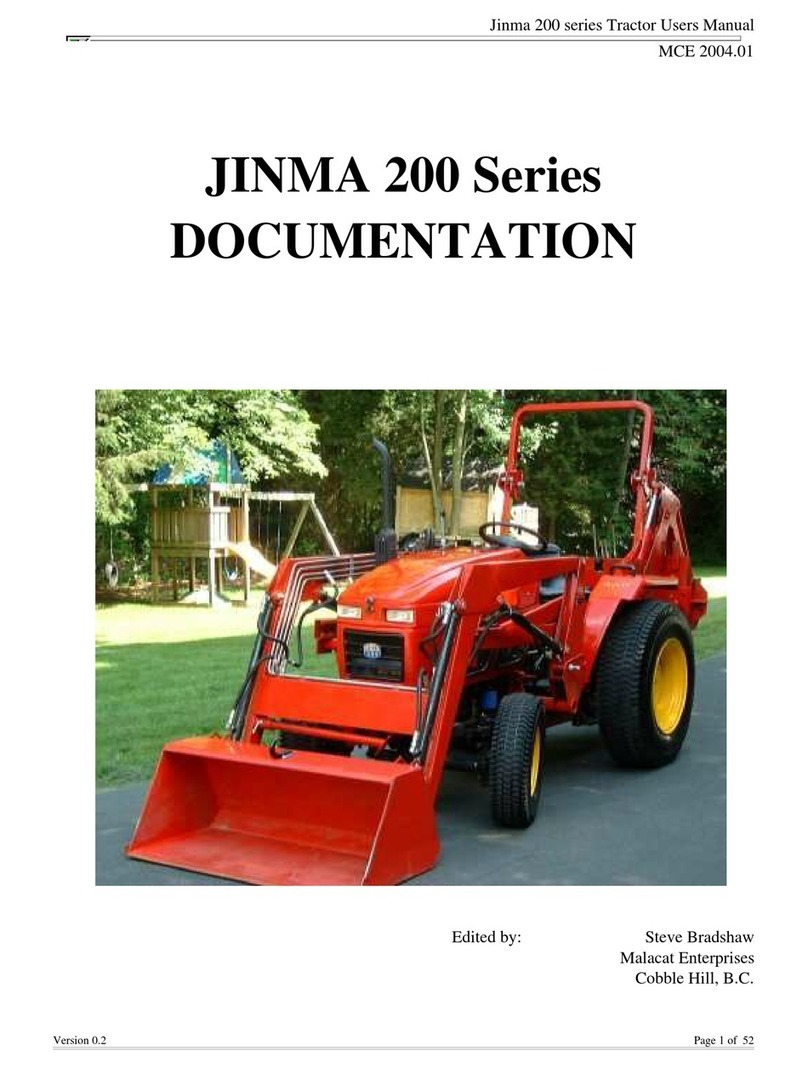
Yancheng Tractor Factory
Yancheng Tractor Factory Jinma 200 Series user manual

Gravely
Gravely Rapid M 985403 Owner's/operator's manual
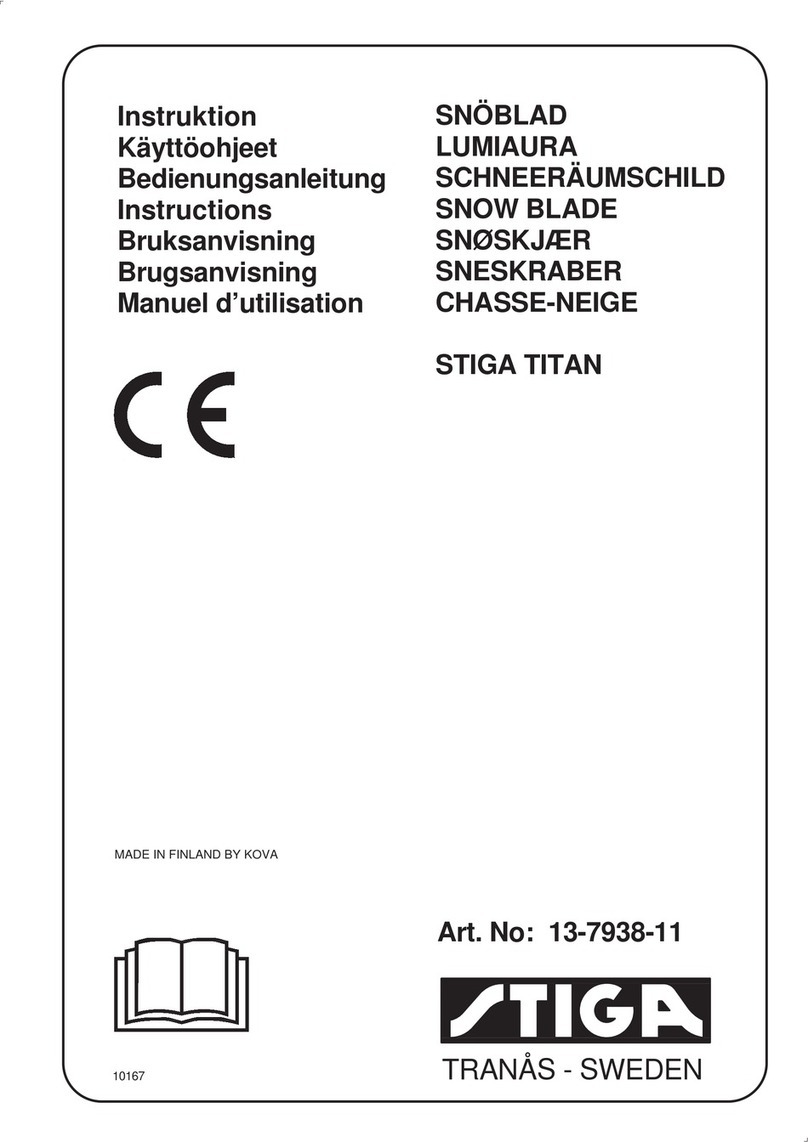
Stiga
Stiga TITAN instructions
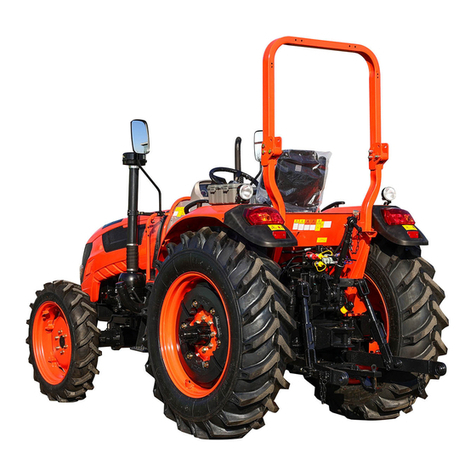
DEUTZ-FAHR
DEUTZ-FAHR FL35-70HP Series Operation manual

Case IH
Case IH Farmall 45A Service manual
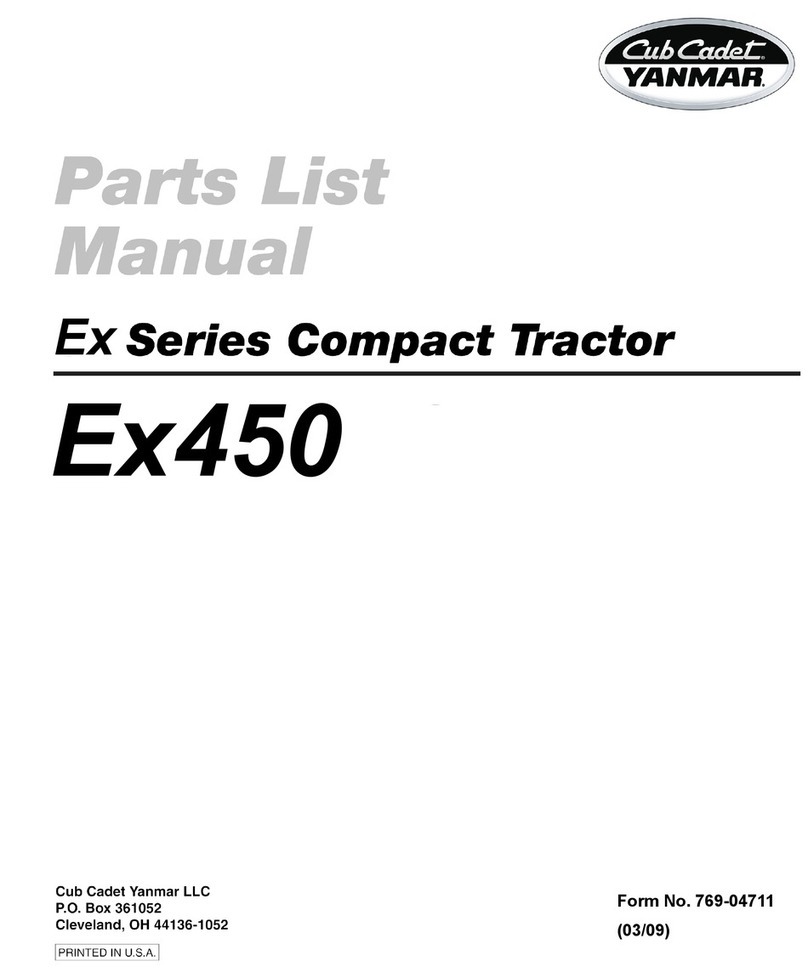
Cub Cadet
Cub Cadet Yanmar Ex450 Part list manual

